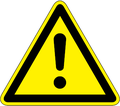Regulation optical radiation
The Austrian ordinance on the protection of workers from exposure to optical radiation (Ordinance on Optical Radiation - VOPST) is a detailed ordinance on the ASchG . VOPST covers employee protection against optical radiation in Austria . It represents the Austrian implementation of the EU Directive 2006/25 / EC.
overview
The VOPST regulates employee protection as soon as optical radiation occurs at the workplace. The term optical radiation includes the areas
This radiation can come from
- artificial sources ("man-made") or
- natural sources (mainly solar radiation)
come. The artificial sources also include laser radiation and are therefore recorded by the VOPST, although there are specific limit values due to the properties and different standardization histories. This is also reflected in the two annexes in which exposure limit values for occupational safety are defined.
- Appendix A: Exposure limit values for broadband radiators (incoherent optical radiation)
- Appendix B: Exposure Limits for Lasers (Coherent Optical Radiation)
scope of application
The VOPST is to be applied
- in workplaces
- on construction places
- at external jobs
implementation
The VOPST basically requires a risk assessment . This is
- for all workplaces where optical radiation occurs
- without exception of trivial sources
- according to the state of the art
- with sufficient specialist knowledge
- taking into account the STOP principle
perform.
Expertise
The employer must ensure that the risk assessment is carried out with sufficient specialist knowledge. There is no concrete information on this. In any case, the specialist knowledge must be appropriate to the hazard potential.
Labelling
Labeling is required if exposure limit values due to radiation from artificial sources are exceeded. The marking must be clearly recognizable. It must be ensured that this marking is recognized before access to the danger area. Identification of hazards according to VOPST (with symbols from the KennV):
Mandatory signs for wearing PPE:
Risk assessment (evaluation)
According to the ASchG, the employer is obliged to carry out a risk assessment. In the area of optical radiation, this applies to all exposures to optical radiation. This means that virtually every workplace has to be evaluated with regard to VOPST.
Risk assessment for optical radiation from artificial sources
The exposure limit values specified in Appendix A and Appendix B apply. If these exposure limit values are complied with, the worker is protected from the harmful effects of optical radiation. The ZAI's guideline for artificial optical radiation can be used for assessment.
Risk assessment for broadband radiators (lights, lamps, ...)
The following limit values are possible:
- Actinic UV: H eff = 30 J / m 2 within 8 hours
- UVA: H UVA = 10000 J / m 2 within 8 hours
- Blue light hazard
- Retina thermal
- Retina thermal with weak visual stimulus
- Cornea thermal
- Skin thermal
In a specific application, one can often concentrate on 1 or 2 limiting limit values due to the exposure.
Another possibility is the assessment according to risk classes according to EN 62471.
Risk assessment for lasers
The laser emits coherent optical radiation. The limit values depend on the wavelength and the duration of exposure. The laser classes enable a simplified and practical assessment according to the state of the art . Basically, the manufacturer must specify the laser class, the laser wavelength, the power and any other rules of conduct for the employee.
For older machines that still use the ANSI system of laser classification, there is a decree of the ZAI in order to be able to assign these laser classes to the current scheme and thus enable an evaluation.
Risk assessment for optical radiation from natural sources
With the inclusion of solar radiation, the VOPST goes beyond the minimum requirements of EU Directive 2006/25 / EC. The employee must be protected from solar radiation. A risk assessment must be carried out. Exposure limit values do not exist. A risk assessment based on the state of the art must be carried out. The state of the art is the shade rule, the UV index or an estimate based on time of day and season. The guidelines for natural optical radiation of the ZAI can be used to assess the risk of natural optical radiation. Special factors such as the height of a workplace, reflective surfaces (water, sheet metal, ...) etc. must be taken into account.
Protection against natural optical radiation (sun protection)
Section 10 of the VOPST summarizes all provisions of the ASchG that are applicable to natural optical radiation. In principle, a risk assessment must also be carried out in the case of natural optical radiation (e.g. according to the ZAI guidelines). According to the result, protective measures are to be defined and applied and the personnel to be instructed. The application of exposure limit values, classification, delimitation and labeling are not necessary.
Implementations in other EU countries
- DE: OStrV
- FR: Décret n ° 2010-750 du 2 juillet 2010 relatif à la protection des travailleurs contre les risques dus aux rayonnements optiques artificiels
- IT: Legislative Decree, n.81/2008
- UK: The Control of Artificial Optical Radiation at Work Regulations 2010
- PL:
- Rozporządzenie Ministra Pracy i Polityki Społecznej w sprawie bhp przy pracach związanych z ekspozycją na promieniowane optyczne z dnia 27 maja 2010 r. (Dz. U z 2010 no 100 poz. 643)
- Rozporządzenie Ministra Pracy i Polityki Społecznej z dnia 29 lipca 2010 r. zmieniające rozporządzenie w sprawie najwyższych dopuszczalnych stężeń i natężeń czynników szkodliwych dla zdrowia w środowisku pracy (Dz. U. z 2010 nr 141 poz. 950)
- Rozporządzenie Ministra Zdrowia z dnia 8 grudnia 2010 r. zmieniające rozporządzenie w sprawie przeprowadzenia badań lekarskich pracowników, zakresu profilaktycznej opieki zdrowotnej nad pracownikami oraz orzeczeń lekarskich wydawanych do celów przewidzianych 2010 nr. 240 przewidzianych.
- Rozporządzenie Ministra Zdrowia z dnia 2 lutego 2011 r. w sprawie badań i pomiarów czynników szkodliwych dla zdrowia w środowisku pracy (DzU z 2011 nr 33 poz. 166).
- ES: REAL DECRETO 486/2010, de 23 de april BOE nº 99, de 24 de april
- SI: Uredba o varovanju delavcev pred tveganji zaradi izpostavljenosti umetnim optičnim sevanjem
Web links
- VOPST (PDF; 4.0 MB)
- EU Directive 2006/25 / EC (PDF)
- Overview of optical radiation (Central Labor Inspectorate)
- UV index in Austria
- Guide to Artificial Optical Radiation
- ZAI
- Guide to natural optical radiation
Individual evidence
- ↑ ZAI decree 461.209 / 77-III / 2/02: LASER, new classification, new standards and specifications. of December 10, 2002 ( PDF ( Memento of October 17, 2007 in the Internet Archive ))






